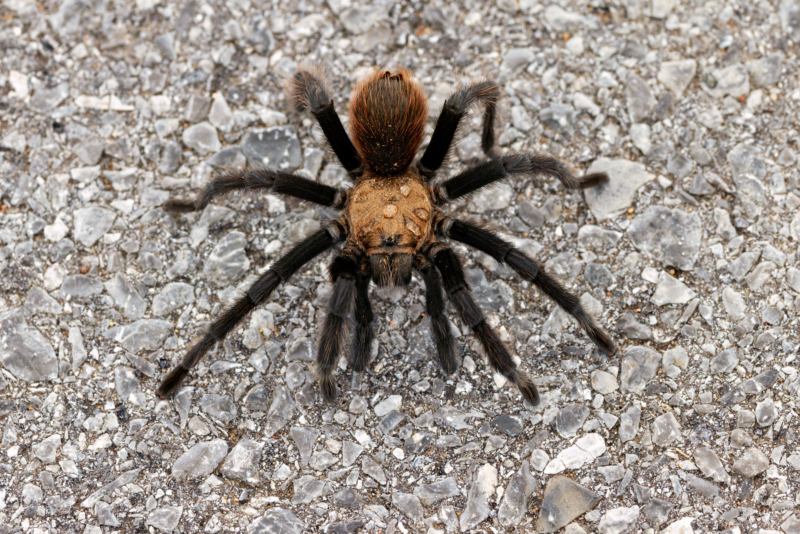They’re the poster child of Halloween horror, the creepy crawler that makes adults jump, and the misunderstood arachnid that’s far more afraid of you than you are of it. This Halloween season, let’s set the record straight about one of nature’s most maligned creatures: the tarantula.

The Perfect Halloween Mascot (That Doesn’t Deserve the Bad Rap)
Walk into any Halloween store and you’ll find rubber tarantulas dangling from fake webs, their exaggerated fangs feeding old fears. But the real tarantulas crawling across the American Southwest are fascinating creatures that deserve appreciation, not panic.
This one was photographed on rocky terrain in a classic defensive pose. Notice the slightly raised front legs, that’s its polite way of saying “back off.” Despite their reputation, tarantulas rarely bite. They would much rather retreat than fight.
Wildlife Notes: Debunking the Myths
Size and Danger
Most North American tarantulas have a leg span of 4–6 inches, though a few reach 8 inches. Their bite, while painful, is about as bad as a bee sting. Their venom targets small insects, not humans. There are no recorded deaths from tarantula bites in North America.
Behavior and Defense
Tarantulas rely on two main defenses, a rare bite and their barbed urticating hairs. Those fuzzy abdominal hairs can be flicked toward predators, causing irritation. It’s a smart, non-lethal defense. Save venom for prey.
Habitat and Activity
Tarantulas are most active during warm months, especially late summer and fall when males roam for mates. That’s why you often spot them near Halloween. It’s mating season, not mischief night.
Lifespan
Female tarantulas can live 20–30 years in the wild. Males only live 5–10 years and often die soon after mating. A short but dedicated life.
Photography Notes: Capturing Arachnid Details
Gear and Settings
Camera: Canon EOS R5
Lens: RF 100–500mm F4.5–7.1 L IS USM
Focal Length: 324mm
Aperture: ƒ/10
Shutter Speed: 1/1000s
ISO: 3200
The long focal length kept a safe distance while maintaining fine detail. The ƒ/10 aperture provided enough depth of field to keep the spider sharp against the gravel. A 1/1000s shutter speed froze subtle leg motion, and ISO 3200 preserved detail with minimal noise thanks to the R5’s strong sensor.
Composition and Light
The gravel surface adds texture contrast, and the golden-tan cephalothorax stands out against the gray background. Photographing from above provided a clear, symmetrical view that shows the tarantula’s full shape and defensive stance. This top-down angle works well for identification and emphasizes the spider’s pattern and structure.
Safety and Ethics
Never pick up or provoke wild tarantulas. Use telephoto or macro lenses to keep distance. This individual raised its legs in awareness, but I stayed about three feet back to avoid stress.
The Halloween Connection
For Halloween photography, tarantulas offer natural drama with no props needed. Their dark legs and light bodies create spooky contrast, especially in morning or late-day light. Nature provides all the atmosphere you need.
Why Tarantulas Matter
Beyond the myths, tarantulas play vital roles as pest controllers, feeding on insects and small creatures. They are also food for roadrunners, hawks, and tarantula hawk wasps. In many cultures, they symbolize patience and creativity. Female tarantulas build stable, silk-lined burrows that regulate heat and humidity. Each is a tiny masterpiece of design.
This Halloween, Look Closer
Next time you see a fake tarantula in a store, remember the real one. These ancient survivors are more engineer than monster. They don’t want your candy, just a quiet life underground.
If you enjoy Halloween-themed wildlife posts, see my Haunting Presence of the Great Horned Owl.
This Halloween, instead of screaming at eight legs, take a moment to appreciate the design, resilience, and quiet purpose of one of nature’s most remarkable creatures.

Thanks, Very interesting info
Good information !